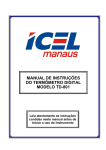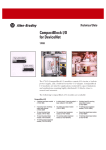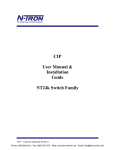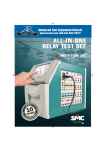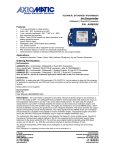Download Clinometer User Manual
Transcript
DeviceNet* Dual Clinometer DESCRIPTION:____________________________________________ The Matric Dual Inclinometer is a smart sensor capable of measuring angles of +/- 55º in two orthogonal axes. The unit is capable of communicating to a DeviceNet* scanner, which is the gateway to a PLC or PC monitoring & control system. The fully sealed rugged aluminum enclosure is designed to withstand long-term abuse, making it ideal for industrial applications requiring measurement of several axes simultaneously. SPECIFICATIONS:__________________________________________ Performance • Total Range: +/- 55º • Linear Range: +/- 40º • Threshold: 0.001º • Linearity: Null to 5º: +/- 0.1º 5 to 40º: +/- 1% 40 to 55º: monotonic • Null Repeatability: 0.05º • Cross Axis Error: <1% up to 45º • Time Constant: 0.3 second • Frequency Response (-3db): 0.5 Hz Power Requirements • Network supplied 11-24 VDC 110-55 mA respectively Communications • 125K, 250K, 500K baud • Media Access Control Identifier (MAC ID) • Group 2 predefined master/slave connection set • Binary Range: 15 bits + sign bit • Scale Factor: 500 counts / degree Diagnostics • LEDs Bi-color, red/green DeviceNet* standard (Module, Network, I/O) Environmental • Sealed: IP65 • Operating Temperature: -30º to 65º C • Storage Temperature: -55º to 65º C • Temperature Coefficient Null: 0.008º / ºC Scale Factor: 0.1% / ºC Dimensions • Enclosure: 3.343 inches X 4.7 inches X 2.926 inches • Mounting Flange: 5.669 inches X 3.9 inches APPLICATION:____________________________________________ The Dual Inclinometer measures inclination in two axis using liquid filled capacitive sensors and outputs the data in response to a poll message from a DeviceNet* scanner. The nature of the sensors provides a certain vibration dampening effect that is desirable in certain applications. The Dual Inclinometer is calibrated to absolute “zero” (level) at the factory by establishing an internal offset in software. In other words, the angle sensors inside the unit are not physically leveled with respect to the enclosure, but the unit’s software will compensate and give the proper “zero” degree reading when the unit is level. A side effect of this calibration method is that the angular measurement range specification of the sensors will be asymmetrical by their particular amount of offset from “zero”. A similar process can be used after the Dual Inclinometer is mounted to equipment to determine an offset that the equipment logic can use to determine level. CONFIGURATION:__________________________________________ The Dual Clinometer is configured via DeviceNet* using a configuration device such a handheld Allen Bradley DeviceView or a PC running RS Linx and RS Networx. DeviceNet devices use Electronic Data Sheets (EDS) to provide the information needed to configure the device and setup a scanner and PLC for communication with the device. An EDS file for the Clinometer is available on the Matric web site. A device profile document is also available which provides additional information on the objects supported by the Clinometer. The Dual DeviceNet Clinometer is shipped with a MACID set to 63 (decimal). It is typical for new DeviceNet devices to have a MACID of 63, therefore, the MACID should be set to a different network address after the Clinometer is added to a network. To avoid conflicting addresses and confusing device identities, make sure network address 63 is available before adding the Clinometer to a network. When the Clinometer is first added to a network, the indicators will show Module solid green (indicating that the device is functioning), Network blinking green (indicating that the device is not connected to any device in the network), and IO blinking green (indicating that the device has data available, but is not being asked to produce data). RS Linx will discover the Clinometer and add it to the network as node address 63, DUALINCL. The PLC and scanner can request sensor data from the Clinometer using an explicit “Get Attribute Single” without adding it to the scanner card’s scanlist. While the Clinometer is processing the explicit message the Network indicator will show solid green, but the IO indicator will continue blinking since the device is not being polled. If the Clinometer is commissioned and added to the scanner’s scanlist, all indicators will show solid green indicating that it is working, connected to the scanner, and being polled. Run time data is produced by the Clinometer and is available by executing a Get Attribute explicit message sequence. RS Networx provides a dialog called the Class Instance Editor which can be used to manually execute a Get Attribute request. The Clinometer sensor data is the third Attribute (3) in the first Instance (1) of the Assembly Object (Class 4). The Clinometer will respond to a Get Single Attribute request by producing two 16 bit values. The first word corresponds to the A axis shown on the Clinometer label. The second word corresponds to the B axis. The most significant bit of the value is a direction bit. When the direction bit is set (1), the Clinometer is tilted in the “-” direction as shown on the Clinometer label. Data tables and ladder logic can be used to execute the explicit Get Single Attribute request in an operational PLC control system. The system integrator will create a data table which holds the explicit request information as shown below. An explicit request consists of a Transaction Header followed by Transaction Data. In the Transaction Header, the COMMAND field is set to 1 to tell the scanner to execute the request, the SERVICE field is set to 0x0E to request a Get Single Attribute, and the SIZE field is 6 to show the number of bytes of transaction data in the request. The remaining header field values are chosen by the system integrator. In the Transaction Data, the first word is the CLASS (4), the second word is the INSTANCE (1) and the last word is the ATTRIBUTE (3). This data is copied by the PLC to the scanner’s M0 file to execute the request. The scanner will place the Clinometer’s response in the M1 file for the PLC to retrieve. TxId (0x??) Command (0x01) Port (0x??) Size (0x06) Service (0x0E) MAC Id (0x??) Class (0x0004) Instance (0x0001) Attribute (0x0003) For more information, please refer to the following documents which are available from Allen Bradley / Rockwell or the ODVA (Open DeviceNet Vendors Association). BULLETIN 1203-GK5 & 1336-GM5, 1747-SDN DEVICENET SCANNER (SLC-500) EXPLICIT MESSAGING, Faxback Document # 3040, Web Location www.ab.com, Pages 7 and 8 show how to set up data tables to send explicit messages and receive the response message. Page 9 shows how to set up ladder logic to communicate using explicit messages. Pages 10-14 give examples of data tables. THE CIP NETWORKS LIBRARY, Volume 1, Common Industrial Protocol, Publication Number: PUB00001, Web Location www.odva.org, Appendix A covers explicit messaging and section A-4-12 deals specifically with the Get Attribute Single service request. Chapter 7 deals with EDS files and configuration issues. 1747-SDN DeviceNet Scanner Module User Manual, Catalog Number 1747-SDN Series C, Publication 1747-UM655B-EN-P, Web Location www.rockwellautomation.com, Appendix E deals with explicit messaging. Page 144 gives a basic overview of how a DeviceNet* system processes an explicit message. Pages 150 and 151 contain tables showing service codes and error codes. INDICATORS:________________________________________________________ The Clinometer provides three diagnostic LED indicators. The LEDs are labeled “Module”, “Network”, and “I/O”. The behavior of these indicators conforms to DeviceNet* and is described below. Refer to “The DeviceNet* Communication Model and Protocol” Chapter 8 for complete details regarding DeviceNet* states and indicators. Module Indicator - In general, this indicator shows the status of the unit itself. For This State: The LED is: To Indicate: No Power Off Device Operational Green Device In Standby Flashing Green There is no power applied to the device. The device is operating in a normal condition. The device needs commissioning due to configuration missing, incomplete, or incorrect. Minor Fault Flashing Red Unrecoverable Fault Red Device Self Testing The device has a recoverable fault. The device has an unrecoverable fault and may need to be replaced. Flashing Red/Green The device is in self test. I/O Indicator - In general, this indicator shows the status of the unit. For This State: The LED is: To Indicate: No Power Off Not used. I/O Active Green I/O Ready Flashing Green The unit is transmitting angle data to the network. The unit is reading angle data from the sensors but is not being polled. N/A Flashing Red Error Red N/A Not used. The unit is not reading data from the sensors. Flashing Red/Green Not used. Network Indicator - In general, this indicator shows the status of the communication link between the DeviceNet* network and the unit. For This State: The LED is: To Indicate: No Power/ Not Online Off There is no power applied to the device or the device has not yet completed power up testing. Online, Not Connected Flashing Green The device is online, but has no connections to other nodes. Link OK Green Connection Time Out Critical Link Failure Flashing Red The device is online, and has connections to other nodes. One or more I/O connections have timed out. The device has detected an error that has rendered it incapable of communicating on the network. Communication Faulted Flashing Red/Green The device has detected a Network Access error and has received an Identify Communication Faulted Request – Long Protocol message. Red INSTALLATION:_______________________________________________________ The Clinometer can be bolted directly to a control panel using the mounting flanges. See the diagram below for mounting dimensions. 0.59 1.06 DEVICE NET 3.56 4.75 See Detail A for mounting hole dimensions 1.16 0.59 0.28 5.66 0.66 2.91 1.44 0.66 0.66 Detail A 0.75 4.16 0.75 5.06 0.30 0.30 The Clinometer provides a sealed male (pins) mini style connector that complies with the physical standards for DeviceNet* connectors. A DeviceNet* tap is used to interface to the DeviceNet* trunk line. The pinout for the connector is shown below. 5 4 1 2 3 1 - Drain 2 - V+ 3 - V4 - CAN_H 5 - CAN_L Matric 2099 Hill City Road Seneca, PA 16346 814-677-0716 www.matric.com Document: OM 185-0058 R1.doc *DeviceNet is a registered trademark of ODVA Copyright 2008, Matric













